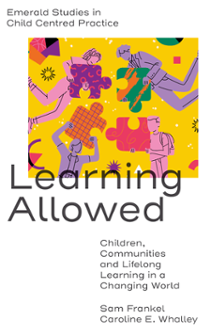
Introducing the Connected Learner in Practice
ISBN: 978-1-80117-401-5, eISBN: 978-1-80117-400-8
Publication date: 13 November 2023
Citation
Frankel, S. and Whalley, C.E. (2023), "Introducing the Connected Learner in Practice", Learning Allowed (Emerald Studies in Child Centred Practice), Emerald Publishing Limited, Leeds, pp. 89-91. https://doi.org/10.1108/978-1-80117-400-820231016
Publisher
:Emerald Publishing Limited
Copyright © 2024 Sam Frankel and Caroline E. Whalley. Published under exclusive licence by Emerald Publishing Limited
Chapters 3–5 allowed us to explain the ‘connected learner’ in theory, through a focus on the ‘learner with agency’, ‘learning as navigation’ and ‘learning by consent’. It gave us a chance to map a landscape which is littered with obstacles that might limit or restrict our learning connectivity, as well as recognising those ways in which connections can be enhanced.
The following chapters draw on our experience of learning with children, and offers a framework through which the ideas set out at the start can be put into practice. Although the second half of this book is written to enable school-based conversations, the framework has much wider application (for example, in a youth work context or adult learning centres) and in keeping with the arguments throughout this book, is applicable to all learners whatever their age.
Inviting You to ‘Plug In’
Developing a Culture of Advocacy
We identified five steps focused on maximising the connectivity within a learning environment, which in different ways link to value, voice and vision. The process is not linear, each step, is not an end in itself, but sets in motion conversations to trigger a re-imagining of your practice. There isn't a check list but we will explore some principles that can shape your discussions and form a basis for you to take positive action.
Chapter 6. ‘P’ – power up your learner centred ethos
Chapter 7. ‘L’ – nurture a ‘learn to be’ culture
Chapter 8. ‘U’ – unify your language
Chapter 9. ‘G’ – grow meaningful opportunities
Chapter 10. ‘IN’ – Inspire lead learner
About 15 years ago I walked into a school led by a friend and colleague John Fowler. Straight away the school felt ‘different’. It was not the welcome by the staff at the front desk, it was not the displays on the wall, or the colourful fish tank in the corridor, it was not the neatly piled boxes to one side in the hall, it was the children. There was purpose in their walk and a confidence in their greeting. It was as if I had entered, the fabled offices of a big Californian tech giant (at least in my imagination), and despite there being no table tennis tables and no-one on scooters (again my imagination), there was a sense of passion and purpose in the movement of the ‘young executives’ that were around me. You sensed a hunger to pursue the next task and an excitement about what might be discovered. In short there was an overwhelming desire to learn.
(Frankel & Fowler, 2016)
It is that dimension of practice that we want to be the focus in Part 2. Each of the chapters has been written to use as a resource to support professional conversations.
To frame these conversations and to support an environment designed to enable all learners to ‘plug in’ and connect, our approach encourages you to search for a ‘culture of advocacy’ – defined by ‘establishing the voice of the child’ and ‘amplifying the voice of the child’ (Frankel, 2018a). This model that invites adults, in any space that they share with children or other learners, to ask themselves a series of questions to reflect on their practice. This approach supports strongly our ambition to advance practices that lead towards connected learning.
Each of the Chapters 6–10 follows the format
Have an Idea
We give you our idea(s) – as a question that offers a starting point for a learning journey of your own.
Talk Listen and Plan
We share some information with you. You can use it to trigger your thinking, either independently or with others – build conversations!
Give It a Go
Provides a practical way in which you can explore the question that we set out – this forms a basis to expand on and gain further understanding and we hope develop your own approaches.
Keep on Learning
We will connect this thinking to the wider goal of the lifelong learner and share some final thoughts reflections and references that you might find useful.
- Prelims
- Chapter 1 We Need to Talk About… Allowing Learning!
- Chapter 2 An Approach – To Allowing Learning
- The Connected Learner in Theory
- Chapter 3 Who Is a Learner?
- Chapter 4 What Is Learning For?
- Chapter 5 How We Can Allow Learning: Impact of Self and ‘Other’ on Our Learning Identities
- The Connected Learner in Practice
- Introducing the Connected Learner in Practice
- Chapter 6 ‘P’ – Power Up Your Thinking
- Chapter 7 ‘L’ – Nurture a ‘Learn to Be’ Culture
- Chapter 8 ‘U’ – Unify Your Language
- Chapter 9 ‘G’ – Grow Meaningful Opportunities
- Chapter 10 ’IN’ – Inspire Lead Learners
- Chapter 11 The Individual as a Connected Learner
- Chapter 12 Enduring Connections – Learning Allowed
- References
- Index